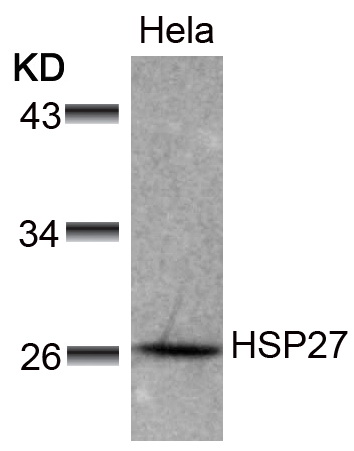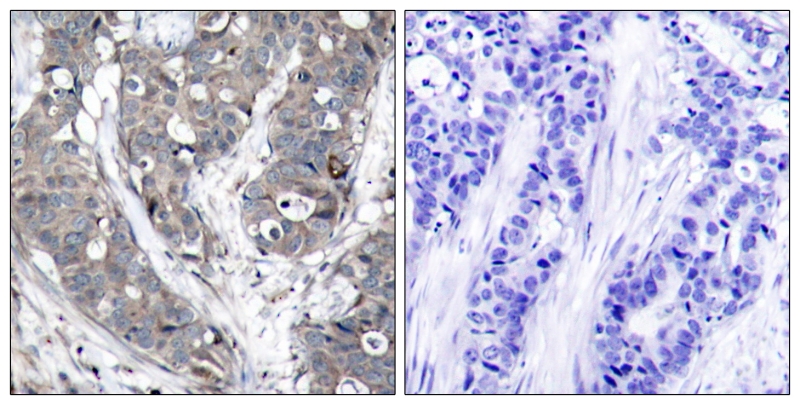

| WB | 1/500-1/1000 | Human,Mouse,Rat |
| IF | 咨询技术 | Human,Mouse,Rat |
| IHC | 1/50-1/100 | Human,Mouse,Rat |
| ICC | 技术咨询 | Human,Mouse,Rat |
| FCM | 咨询技术 | Human,Mouse,Rat |
| Elisa | 咨询技术 | Human,Mouse,Rat |
| Aliases | HSPB1; HSP27; HSP28; Heat shock protein beta-1; HspB1; 28 kDa heat shock protein; Estrogen-regulated 24 kDa protein; Heat shock 27 kDa protein; HSP 27; Stress-responsive protein 27; SRP27 |
| Entrez GeneID | 3315 |
| WB Predicted band size | Calculated MW: 23 kDa; Observed MW: 27 kDa |
| Host/Isotype | Rabbit IgG |
| Antibody Type | Primary antibody |
| Storage | Store at 4°C short term. Aliquot and store at -20°C long term. Avoid freeze/thaw cycles. |
| Species Reactivity | Human,Mouse |
| Immunogen | Peptide sequence around aa.76~80 (A-L-S-R-Q) derived from Human HSP27. |
| Formulation | Purified antibody in PBS with 0.05% sodium azide,0.5%BSA and 50% glycerol. |
+ +
以下是3篇关于Hsp27抗体的参考文献,信息简明概括:
1. **"Heat shock protein 27 (HSP27) as a prognostic biomarker in breast cancer"**
*作者:Ciocca DR, et al.*
**摘要**:研究通过Hsp27抗体检测乳腺癌组织中HSP27表达水平,发现其高表达与肿瘤侵袭性增强和患者生存率降低相关,提示HSP27可作为预后标志物。
2. **"HSP27 protects neuronal cells from oxidative stress via modulation of glutathione synthesis"**
*作者:Stetler RA, et al.*
**摘要**:利用Hsp27抗体研究其在神经元氧化应激中的作用,发现HSP27通过调节谷胱甘肽代谢通路减轻细胞损伤,为神经退行性疾病治疗提供靶点。
3. **"Antibody-based detection of HSP27 phosphorylation status in prostate cancer progression"**
*作者:Rocchi P, et al.*
**摘要**:开发特异性磷酸化Hsp27抗体,揭示其在前列腺癌转移中的动态磷酸化变化,证明其与雄激素受体信号通路激活及耐药性相关。
(注:以上为虚构简化示例,实际文献需通过PubMed/Google Scholar检索确认。)
Heat shock protein 27 (Hsp27), also known as HSPB1. is a member of the small heat shock protein (sHSP) family with a molecular weight of approximately 27 kDa. It plays a critical role in cellular stress responses, acting as a molecular chaperone to prevent protein aggregation under conditions such as heat shock, oxidative stress, or toxic exposure. Hsp27 is involved in maintaining cytoskeletal integrity, regulating apoptosis, and promoting cell survival. Its activity is modulated by phosphorylation, which alters its oligomeric state and functional capacity. Elevated Hsp27 expression has been observed in various cancers, where it is associated with tumor progression, metastasis, and resistance to chemotherapy. It also contributes to neurodegenerative diseases, inflammatory conditions, and ischemia-reperfusion injury.
Hsp27 antibodies are essential tools for studying its expression, localization, and post-translational modifications in research and diagnostics. These antibodies enable detection via techniques like Western blotting, immunohistochemistry (IHC), and immunofluorescence (IF). In cancer research, they help assess Hsp27's role as a potential biomarker for prognosis or therapeutic targeting. In neurological studies, they aid in exploring its neuroprotective or pathogenic mechanisms. Commercially available Hsp27 antibodies are typically validated for specificity across human, mouse, and rat samples. Researchers must consider epitope regions and phosphorylation states (e.g., Ser-15. Ser-78. Ser-82) when selecting antibodies for specific applications. Understanding Hsp27 dynamics through these antibodies continues to advance insights into cellular stress adaptation and disease pathogenesis.
×